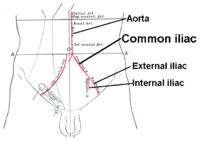
Photo from wikipedia
Abstract Rationale: Common iliac artery aneurysm (CIAA) is complicated by ilio-iliac arteriovenous fistulas (IIAVF), which is rare but fatal and require prompt diagnosis and appropriate treatment. As open repair is… Click to show full abstract
Abstract Rationale: Common iliac artery aneurysm (CIAA) is complicated by ilio-iliac arteriovenous fistulas (IIAVF), which is rare but fatal and require prompt diagnosis and appropriate treatment. As open repair is associated with high morbidity and mortality, endovascular therapy is considered appropriate for treating an IIAVF. Patient concerns: A 76-year-old male patient who developed an IIAVF as a complication of ruptured CIAA, requiring immediate surgical repair presented to the hospital with hemodynamic instability. Diagnosis: Computed tomography angiography and conventional angiography revealed an IIAVF. Intervention: Endovascular therapy was selected to reduce the risk of morbidity and mortality. As the angiogram after the first endovascular aneurysm repair with stent-grafting showed contrast medium filling in the aneurysm sac, right common iliac vein, and the inferior vena cava, an aortic extension cuff was inserted into the right common iliac vein to close the orifice on the venous side. Outcomes: The right lower leg edema and discomfort were resolved immediately after the procedure, with the vital signs remaining stable. Computed tomography performed 6 months postoperatively showed patent stent-grafts of the artery and vein, with no evidence of IIAVF and endoleak. Lessons: IIAVF following CIAA rupture can be repaired successfully by stenting of the common iliac vein with an aortic extension cuff. For successful endovascular repair, the vein side of the fistula tract should be excluded with a stent-graft to block the backflow into the aneurysm sac.
Journal Title: Medicine
Year Published: 2022
Link to full text (if available)
Share on Social Media: Sign Up to like & get
recommendations!